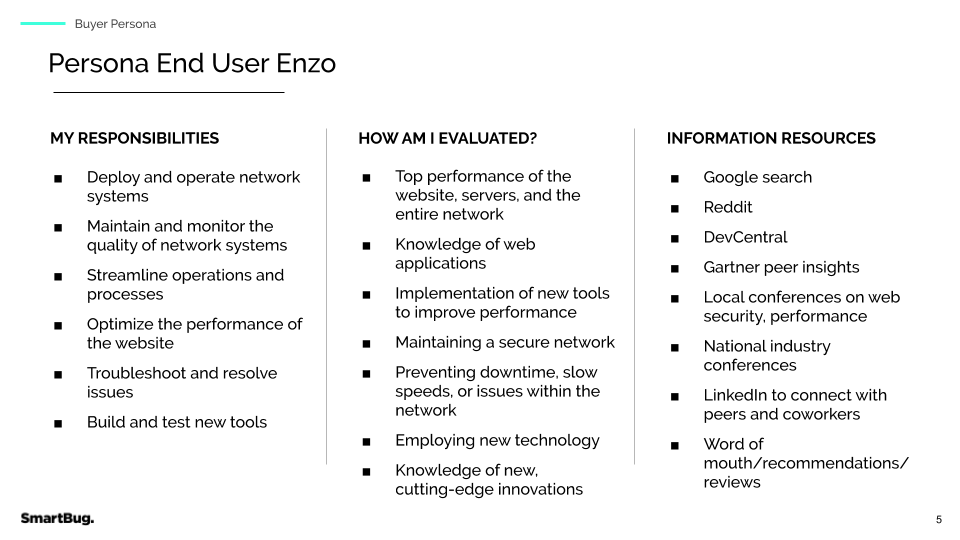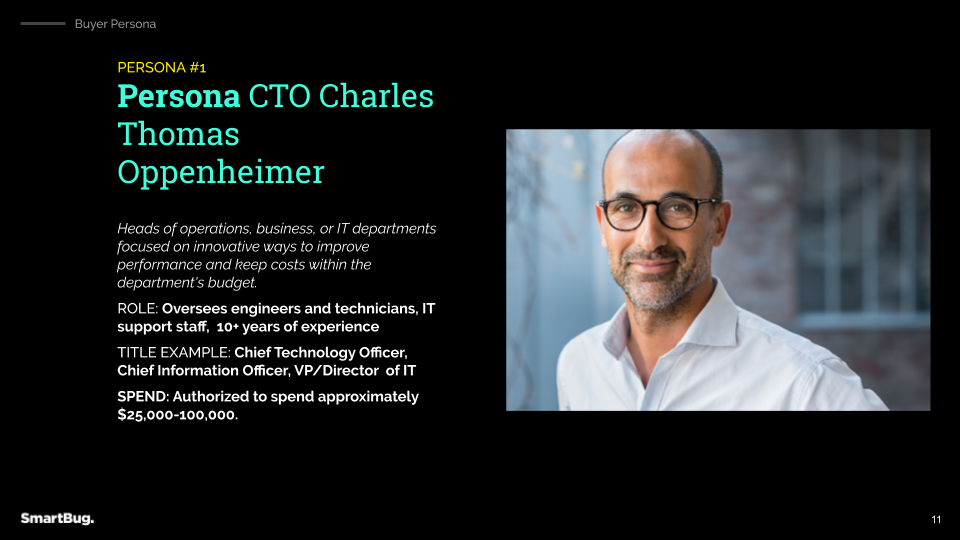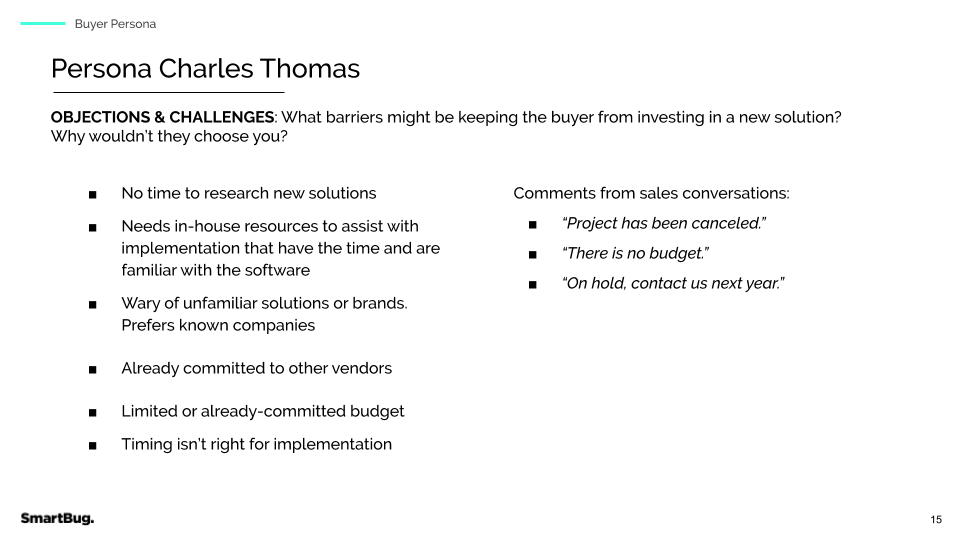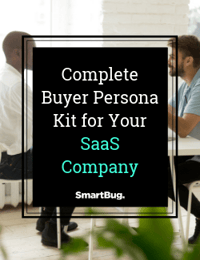
Closing the Sale: Marketing to Software Users vs. Decision Makers for Your Tech Company
June 25, 2019
By Kate Uhry
Let’s talk about your buyer personas. As a SaaS (software as a service) company, you may have two, perhaps four, buyer personas, most likely broken into two main categories—end users and decision makers. Each one plays a critical role when it comes to buying your products. It’s up to you as the marketing expert to make sure that you treat them differently during the Buyer’s Journey, up until the point of closing the sale. But what distinguishes one from the other? And how exactly should you be marketing to each? Let’s find out.
Who’s Who
The best way to find out who is making the decision to buy your product is by asking your existing customers. The next time you meet with them in person or talk to them on the phone, ask if they would be willing to talk about the buying process they went through in their decision to hire you. You can then ask questions like:
- Who identified that there was a problem that needed a solution?
- Was it the end user or the decision maker?
- Who was involved in the Buyer's Journey?
- Who did the initial research?
- Was there a point where a decision maker was brought in?
- Who was responsible for the budget?
- What information did they trust to make their decision?
- What features did they evaluate as they looked at the various choices?
- What made them choose you?
- Ultimately, who had the final say?
Listen for titles, processes, and other clues as to who was involved. While the assumption might be that the end user and/or the head of the technology or operations department made the decision, there may be a case where someone in the financial department, the head of the company, stakeholders, or investors had to sign off on the spend—especially if it was a significantly large purchase.
Painting the Picture: Developing Details
As you talk to your customers and begin to identify the role and perhaps the title of each user and decision maker involved, start to fill in the details of your buyer personas. It’s not enough to just interview those who have already chosen you—you also need to find out about your target audience and who else might want to buy your product.
According to our persona guide, “A buyer persona is a representation of your target customer. It’s a picture you paint based on research and interviews with actual customers. It goes beyond basic demographics to include the intangible elements that make a person tick. Persona development is paramount for the success of an inbound marketing program, no matter the size or scope of your business.”
Online research is the first step in finding the information that will guide you as you create your personas. One great source of information is LinkedIn, where you can search for someone with your target job title and discover their industry associations, responsibilities, who they report to, influencers, and more. Those details will allow to answer persona questions like “where do they get their information when deciding which product to buy” or “how are they held accountable in their job”.
You should also do more interviews with your target audience. That includes a mix of your current customers and possibly both “good” and “bad” prospects, plus anyone else who might fit into your target audience. Be sure you are asking the right questions in these interviews so that you get the answers you need to develop your tech marketing strategies for users versus decision makers. The best way to get started on your marketing plan is to use our SaaS persona template.
(You may also find our guide on personas a good read.)
If you do it right, you’ll end up with buyer personas that start to look a little like the ones below.
SaaS Buyer Persona Examples
Here are two partial examples of personas for a SaaS client: End User Enzo and CTO Charles Thomas Oppenheimer. A complete persona should also include the factors that trigger them to buy, what objections you might hear during a sales call, their elevator pitch to their customers, and more. See the bottom of this article for a full list of questions to ask your personas, or download this template.




(see more buyer persona examples here)
Marketing to Software Users
Once your personas are fully developed, it’s time to get around to creating the tech marketing message for each one. Software users like End User Enzo will want content that tells them how to make their job easier, faster, and better. Starting at the awareness stage, they will want to know you are on the cutting edge of your industry, and that by connecting with you, they’ll be able to stay on top of trends.
This is where you show off your expertise and make them a devoted fan by hitting their buzzwords and answering some of their most common questions. Software end user content, as opposed to decision-maker content, is usually more technical, more instructive, and more focused on tips and tricks. You’ll want to teach them how to get more out of what they have, or as they progress toward deciding to buy from you, dangle new solutions in front of them.
Look at what you have in your arsenal of blogs, webinars, and ultimately, comparison guides. Software reviews and blogs about the best hacks for end users are good for those starting a relationship with you. For those who know and trust you a little better, consider developing case studies that they can relate to or webinars that show them how to use your software features to gain an advantage in their industry.
Your Tech Marketing Message to Decision Makers
Decision-maker content is all about return on investment and keeping costs down. As the head of his department, CTO Charles Thomas needs to prove the value of technology. The technology department is often looked at as a cost center, although it doesn’t have to be.
If he can prove that his department’s investments provide value,a lightning-fast website, flexible and scalable products that grow with the company, no downtime or virus attacks, so the company stays productive—he’s done his job well. Content for this department head should be focused on how to implement new solutions.
Examples of content for decision makers include an ROI tool, a webinar on the best way to help a company that’s expanding into a global market, or a comparison chart of the costs of staying with the existing software versus migrating to a new solution.
Closing the Sale
Closing the sale means getting into your buyer’s head, and that requires having a robust buyer persona. By doing your research and asking the right questions during interviews, you’ll be able to address your buyer’s pain points and buying triggers. You’ll be able to provide answers to their questions, solutions for their problems, and be a trusted source of information. When the time comes, you’ll be the company that is already top of mind, because they’ve been reading your content all along.
------------------
Sample Questions to Ask During the Persona Interview (and Some Examples of What You Might Hear from Typical SaaS Users Versus Decision Makers)
Background
- Basic details about the persona's role such as title and responsibilities
- Key information about their company
Example of a buyer of SaaS products: Focused on value innovation and new services and technology that increase performance and reduce the total cost of operations. Decision making is department-focused, with usually the most senior IT decision maker choosing the technology.
- Relevant information like hobbies or education
Most SaaS buyers are likely to be: College or university educated. Highly technical and skilled and constantly learning.
Demographics
- Gender: This is a predominantly male industry.
- Age range:
- Household income:
- Urbanicity:
Identifiers
- Buzzwords
Examples:
- Best-of-breed product and solution
- Modern models, DevOps focused
- High availability, always online
- Reducing TCO and proving ROI
- Mannerisms or habits
- Personality
- Are they risk-seeking or risk-averse?
Risk-seeking, and at the forefront of technology and trends
- Are they willing to learn new things, or are they know-it-alls?
A mixture of both, highly technical and specialized but with the ability and willingness to learn and adapt to new products and trends
Goals
- What are their goals in work or life?
- What are the secondary and tertiary goals and aspirations?
Challenges
- What are the primary and secondary challenges to this individual meeting these goals?
Users versus decision-maker challenges:
Users: Don’t have buy-in from upper management to implement new software, or lack time to research new solutions
Decision Makers: Needs in-house resources that have the time and are familiar with the software to assist with implementation, already committed to other vendors, limited or already-committed budget, timing isn’t right for implementation
- What's stopping them, and why?
- Have they tried to address it already? What happened?
How You Help
- How do you solve their challenges and how do you help them achieve their goals?
Real Quotes
- What are some real quotes he/she would say or were taken from interviews that represent them well? Maybe something the sales reps have heard? This will make it easier for your team to relate to them.
Common Objections
- What are the most common objections this persona will raise during the sales process?
Marketing Message
- How do you describe your solution to this persona?
Elevator Pitch
- What's your elevator pitch to this specific persona?
Other
- Where do these people look for information to solve their challenges/meet their goals? Conferences? Magazines? Websites?
- Any other information about their personalities, behaviors, fears, biases, and so on, that makes us know them better.
With answers to these questions in hand, you can start to work on your personas.

About the author
Kate Uhry was formerly a Marketing Consultant at SmartBug Media. With a rock solid marketing foundation and years of experience, she loves to help customers grow and achieve their business goals. A graduate of Tufts University, with an MBA from the University of Connecticut, Kate is constantly taking a class somewhere. Her idea of happiness is sitting with a good book, a purring cat and a chocolate chip cookie in the sunshine. Read more articles by Kate Uhry.









